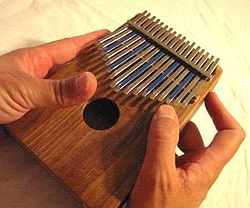Hugh Tracey

Hugh Tracey (1903–1977) was an important twentieth century ethnomusicologist. He and his wife collected and archived music from Southern and Central Africa. He began making field recordings of music in the early 20's, through the 70's.
According to his grandson Devon, the Englishman arrived in South Africa in the 1920s and immediately became fascinated with the local culture. He was particularly interested in the Mbira, an instrument found nowhere else in the world. In his efforts to spread awareness of the Africa’s vast musical heritage, he created an adaptation of the Mbira known as the Kalimba.
The Kalimba, which literally translates as “little music”, was designed so that it could be learned and appreciated internationally. Hugh created the Kalimba so that its melodies and harmonies would be more suited for the western tradition of music. Made from an African hardwood, with notes made out of European spring steel, the Kalimba is known for its tranquil and enchanting sounds.
Today, Kalimbas continue to be handcrafted in a family run workshop in Grahmstown, South Africa. They come in several different models: the treble and celeste treble (17 notes, 2+ octaves), the alto and TM alto (15 notes, 2 octaves), 11 note pentatonic kalimba, the African-tuned karimba, and an 8-note beginner's kalimba.
Tracey founded The International Library of African Music (ILAM) in 1954, and became its director. ILAM publishes the African Music Society Journal. Hugh's son Andrew Tracey also became a well known ethnomusicologist specializing in African music. Another son, Paul, also became a musician and ethnomusicologist.
See also
- International Library of African Music
- Andrew Tracey
- Paul Berliner
- Music of Africa
- Music of Zimbabwe
- Music of Mozambique
- Shona music
- Gravikord
- Thumb piano
Recordings
- Musical instruments 2: (LP) Reeds (Mbira). (1972) The Music of Africa series. 1 LP disc. 33⅓ rpm. mono. 12 in. Recorded by Hugh Tracey. Kaleidophone, KMA 2.
- 21 CDs recorded by Tracey were produced by ILAM- see the link for further information.
Selected publications
- Tracey, Hugh. (1961). The evolution of African music and its function in the present day. Johannesburg: Institute for the Study of Man in Africa.
- Tracey, Hugh. (1969). The Mbira class of African Instruments in Rhodesia. (1932). African Music Society Journal, 4:3, 78-95.
- Tracey, Hugh. (1948,1970). Chopi Musicians. London: Oxford University Press. SBN 19 724182 4. Describes the Timbila of Mozambique.
External links
- "Hugh Traceys Portrait". International Library of African Music. Rhodes University.
- ILAM International Library of African Music
- Review of Tracey's work in ethnomusicology
- Kalimba Magic's interview with Andrew Tracey, which includes information about Hugh Tracey.
|